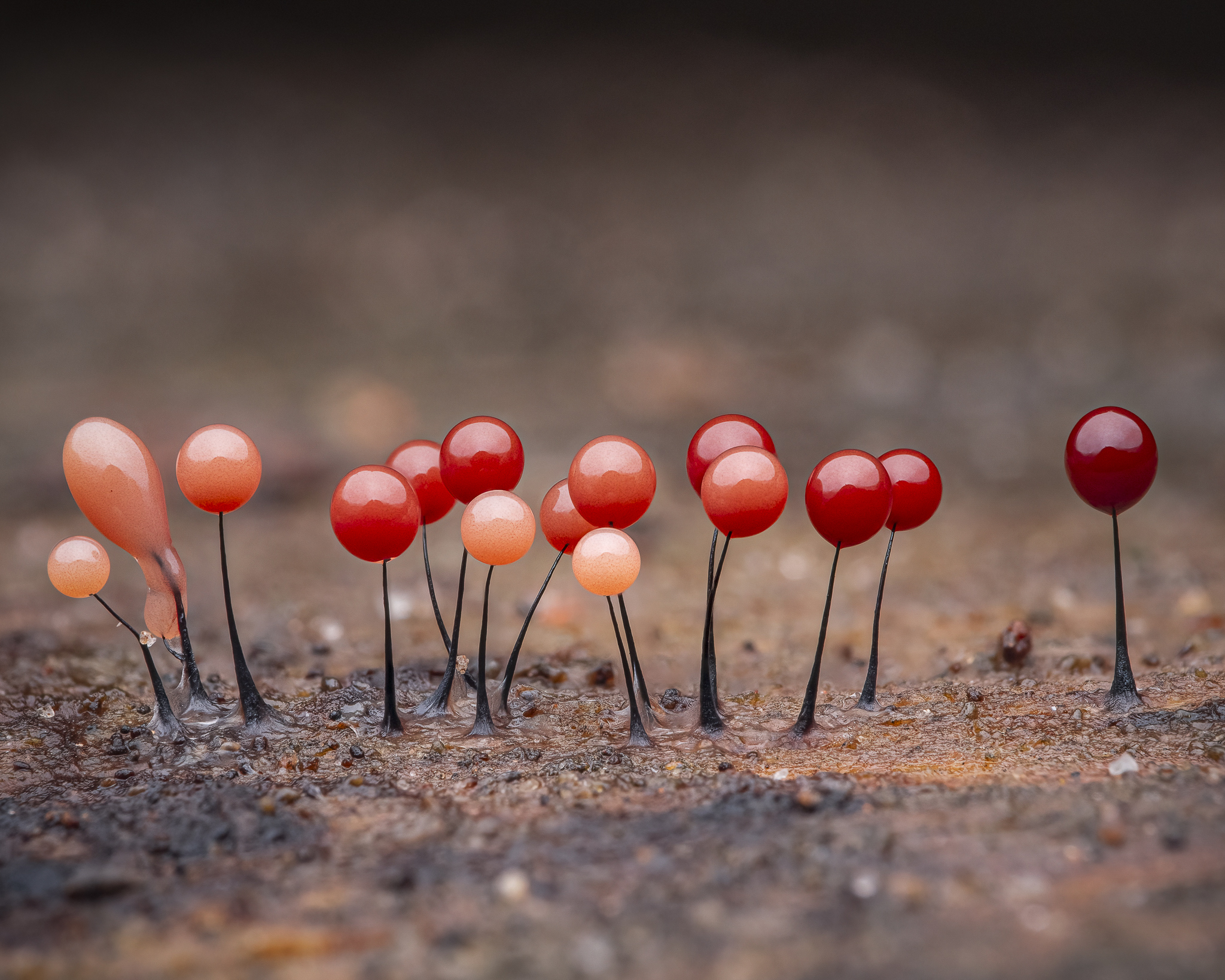|
Slime Mould
Slime mold or slime mould is an informal name given to a polyphyletic assemblage of unrelated eukaryotic organisms in the Stramenopiles, Rhizaria, Discoba, Amoebozoa and Holomycota clades. Most are near-microscopic; those in the Myxogastria form larger plasmodial slime molds visible to the naked eye. The slime mold life cycle includes a free-living single-celled stage and the formation of spores. Spores are often produced in macroscopic multicellular or multinucleate fruiting bodies that may be formed through aggregation or fusion; aggregation is driven by chemical signals called acrasins. Slime molds contribute to the decomposition of dead vegetation; some are parasitic. Most slime molds are terrestrial and free-living, typically in damp shady habitats such as in or on the surface of rotting wood. Some myxogastrians and protostelians are aquatic or semi-aquatic. The phytomyxea are parasitic, living inside their plant hosts. Geographically, slime molds are cosmop ... [...More Info...] [...Related Items...] OR: [Wikipedia] [Google] [Baidu] |
Comatricha Nigra 176600092
''Comatricha'' is a genus of slime molds in the family Amaurochaetaceae. As of 2015, Index Fungorum includes 39 species in the genus. Species *''Comatricha afroalpina'' *''Comatricha aggregata'' *''Comatricha alta'' *''Comatricha anomala'' *''Comatricha brachypus'' *''Comatricha calderaensis'' *''Comatricha ellae'' *''Comatricha filamentosa'' *''Comatricha fragilis'' *''Comatricha fusiformis'' *''Comatricha kowalskii'' *''Comatricha laxa'' *''Comatricha laxifila'' *''Comatricha longipila'' *''Comatricha meandrispora'' *''Comatricha mirabilis'' *''Comatricha nigra'' *''Comatricha nivalis'' *''Comatricha nodulifera'' *''Comatricha nutans'' *''Comatricha orthotricha'' *''Comatricha parvispora'' *''Comatricha pellucida'' *''Comatricha pseudoalpina'' *''Comatricha pseudonigra'' *''Comatricha pulchella'' *''Comatricha pulchelloides'' *''Comatricha reticulospora'' *''Comatricha retispora'' *''Comatricha rigidireta'' *''Comatricha robusta'' *''Comatricha rutilipedata'' *''Comatricha sinu ... [...More Info...] [...Related Items...] OR: [Wikipedia] [Google] [Baidu] |
Parasitism
Parasitism is a close relationship between species, where one organism, the parasite, lives (at least some of the time) on or inside another organism, the host, causing it some harm, and is adapted structurally to this way of life. The entomologist E. O. Wilson characterised parasites' way of feeding as "predators that eat prey in units of less than one". Parasites include single-celled protozoans such as the agents of malaria, sleeping sickness, and amoebic dysentery; animals such as hookworms, lice, mosquitoes, and vampire bats; fungi such as honey fungus and the agents of ringworm; and plants such as mistletoe, dodder, and the broomrapes. There are six major parasitic strategies of exploitation of animal hosts, namely parasitic castration, directly transmitted parasitism (by contact), trophicallytransmitted parasitism (by being eaten), vector-transmitted parasitism, parasitoidism, and micropredation. One major axis of classification concerns invasiveness: ... [...More Info...] [...Related Items...] OR: [Wikipedia] [Google] [Baidu] |
Mycetozoa
Mycetozoa is a polyphyletic grouping of slime molds. It was originally thought to be a monophyletic clade, but in 2010 it was discovered that protostelia are a polyphyletic group within Conosa. Classification It can be divided into dictyostelid, myxogastrid, and protostelid groups. The mycetozoan groups all fit into the unikont supergroup Amoebozoa, whereas most other slime molds fit into various bikont groups ( fonticulids are opisthokonts). Utility in research The dictyostelids are used as examples of cell communication and differentiation, and may provide insights into how multicellular organisms develop. '' Physarum polycephalum'' are useful for studying cytoplasmic streaming. They have also been used to study the biochemical events that surround mitosis, since all of the nuclei in a medium-sized plasmodium divide in synchrony. It has been observed that they can find their way through mazes by spreading out and choosing the shortest path, an interesting example ... [...More Info...] [...Related Items...] OR: [Wikipedia] [Google] [Baidu] |
Heinrich Anton De Bary
Heinrich Anton de Bary (26 January 183119 January 1888) was a German surgeon, botanist, microbiologist, and mycologist (fungal systematics and physiology). He is considered a founding father of plant pathology (phytopathology) as well as the founder of modern mycology. His extensive and careful studies of the life history of fungi and contribution to the understanding of algae and higher plants established landmarks in biology. Early life and education Born in Frankfurt to physician August Theodor de Bary (1802–1873) and Emilie Meyer de Bary, Anton de Bary was one of ten children. He joined excursions of naturalists who collected local specimens. De Bary’s interest was further inspired by George Fresenius, a physician, who also taught botany at Senckenberg Institute. Fresenius was an expert on thallophytes. In 1848, de Bary graduated from a gymnasium at Frankfurt, and began to study medicine at Heidelberg, continuing at Marburg. In 1850, he went to Berlin to continue p ... [...More Info...] [...Related Items...] OR: [Wikipedia] [Google] [Baidu] |
Lycogala Epidendrum
''Lycogala epidendrum'', commonly known as wolf's milk or groening's slime, is a cosmopolitan species of myxogastrid amoeba which is often mistaken for a fungus. The aethalia, or fruiting bodies, occur either scattered or in groups on damp rotten wood, especially on large logs, from June to November. These aethalia are small, pink to brown cushion-like blobs. They may ooze a pink "paste" if the outer wall is broken before maturity. When mature, the colour tends to become more brownish. When not fruiting, single celled individuals move about as very small, red amoeba-like organisms called plasmodia, masses of protoplasm that engulf bacteria, as well as fungal and plant spores, protozoa, and particles of non-living organic matter through phagocytosis (see slime mould for more information). Description During the plasmodial stage, individuals are reddish in colour, but these are almost never seen. When conditions change, the individuals aggregate by means of chemical signalling ... [...More Info...] [...Related Items...] OR: [Wikipedia] [Google] [Baidu] |
Lycogala Epidendrum - Pink And Brown Slime Molds
''Lycogala'' is a genus of Amoebozoa, including the species ''Lycogala epidendrum ''Lycogala epidendrum'', commonly known as wolf's milk or groening's slime, is a cosmopolitan species of myxogastrid amoeba which is often mistaken for a fungus. The aethalia, or fruiting bodies, occur either scattered or in groups on damp rott ...''. References Myxogastria genera Myxogastria {{Amoebozoa-stub ... [...More Info...] [...Related Items...] OR: [Wikipedia] [Google] [Baidu] |
Physarum Polycephalum
''Physarum polycephalum'', an Multinucleate, acellular slime mold or myxomycete popularly known as "the blob", is a protist with diverse cellular forms and broad geographic distribution. The “acellular” moniker derives from the plasmodial stage of the Biological life cycle, life cycle: the plasmodium (life cycle), plasmodium is a bright yellow macroscopic multinucleate coenocyte shaped in a network of interlaced tubes. This stage of the life cycle, along with its preference for damp shady habitats, likely contributed to the original mischaracterization of the organism as a fungus. ''P. polycephalum'' is used as a model organism for research into motility, cellular differentiation, chemotaxis, cellular compatibility, and the cell cycle. It is commonly cultivated. Life cycle and characteristics The two vegetative cell types, amoebae and Plasmodium (life cycle) , plasmodia, differ markedly in morphology, physiology and behavior. Amoebae are microorganisms, typically haploid, ... [...More Info...] [...Related Items...] OR: [Wikipedia] [Google] [Baidu] |
Tropical Rainforest
Tropical rainforests are dense and warm rainforests with high rainfall typically found between 10° north and south of the Equator. They are a subset of the tropical forest biome that occurs roughly within the 28° latitudes (in the torrid zone between the Tropic of Cancer and Tropic of Capricorn). Tropical rainforests are a type of tropical moist broadleaf forest, that includes the more extensive seasonal tropical forests. True rainforests usually occur in tropical rainforest climates where no dry season occurs; all months have an average precipitation of at least . Seasonal tropical forests with tropical monsoon climate, tropical monsoon or tropical savanna climate, savanna climates are sometimes included in the broader definition. Tropical rainforests ecosystems are distinguished by their consistent, high temperatures, exceeding monthly, and substantial annual rainfall. The abundant rainfall results in nutrient-poor, leached soils, which profoundly affect the flora and fau ... [...More Info...] [...Related Items...] OR: [Wikipedia] [Google] [Baidu] |
Tropics
The tropics are the regions of Earth surrounding the equator, where the sun may shine directly overhead. This contrasts with the temperate or polar regions of Earth, where the Sun can never be directly overhead. This is because of Earth's axial tilt; the width of the tropics (in latitude) is twice the tilt. The tropics are also referred to as the tropical zone and the torrid zone (see geographical zone). Due to the overhead sun, the tropics receive the most solar energy over the course of the year, and consequently have the highest temperatures on the planet. Even when not directly overhead, the sun is still close to overhead throughout the year, therefore the tropics also have the lowest seasonal variation on the planet; "winter" and "summer" lose their temperature contrast. Instead, seasons are more commonly divided by precipitation variations than by temperature variations. The tropics maintain wide diversity of local climates, such as rain forests, monsoons, sa ... [...More Info...] [...Related Items...] OR: [Wikipedia] [Google] [Baidu] |
Arctic
The Arctic (; . ) is the polar regions of Earth, polar region of Earth that surrounds the North Pole, lying within the Arctic Circle. The Arctic region, from the IERS Reference Meridian travelling east, consists of parts of northern Norway (Nordland, Troms, Finnmark, Svalbard and Jan Mayen), northernmost Sweden (Västerbotten, Norrbotten and Lapland (Sweden), Lappland), northern Finland (North Ostrobothnia, Kainuu and Lapland (Finland), Lappi), Russia (Murmansk Oblast, Murmansk, Siberia, Nenets Autonomous Okrug, Nenets Okrug, Novaya Zemlya), the United States (Alaska), Canada (Yukon, Northwest Territories, Nunavut), Danish Realm (Greenland), and northern Iceland (Grímsey and Kolbeinsey), along with the Arctic Ocean and adjacent seas. Land within the Arctic region has seasonally varying cryosphere, snow and ice cover, with predominantly treeless permafrost under the tundra. Arctic seas contain seasonal sea ice in many places. The Arctic region is a unique area among Earth's ... [...More Info...] [...Related Items...] OR: [Wikipedia] [Google] [Baidu] |
Atacama Desert
The Atacama Desert () is a desert plateau located on the Pacific Ocean, Pacific coast of South America, in the north of Chile. Stretching over a strip of land west of the Andes Mountains, it covers an area of , which increases to if the barren lower slopes of the Andes are included. The Atacama Desert is the driest nonpolar desert in the world, and the second driest overall, behind some specific spots within the McMurdo Dry Valleys. It is the only Desert climate, true desert to receive less precipitation than polar deserts, and the largest fog desert in the world. The area has been used as an experimentation site for Mars expedition simulations due to its similarities to the Martian environment. The constant Inversion (meteorology), temperature inversion caused by the cool north-flowing Humboldt Current, Humboldt ocean current and the strong South Pacific High, Pacific anticyclone contribute to the extreme aridity of the desert. The most arid region of the Atacama Desert is s ... [...More Info...] [...Related Items...] OR: [Wikipedia] [Google] [Baidu] |
Cosmopolitan Distribution
In biogeography, a cosmopolitan distribution is the range of a taxon that extends across most or all of the surface of the Earth, in appropriate habitats; most cosmopolitan species are known to be highly adaptable to a range of climatic and environmental conditions, though this is not always so. Killer whales ( orcas) are among the most well-known cosmopolitan species on the planet, as they maintain several different resident and transient (migratory) populations in every major oceanic body on Earth, from the Arctic Circle to Antarctica and every coastal and open-water region in-between. Such a taxon (usually a species) is said to have a ''cosmopolitan'' distribution, or exhibit cosmopolitanism, as a species; another example, the rock dove (commonly referred to as a ' pigeon'), in addition to having been bred domestically for centuries, now occurs in most urban areas around the world. The extreme opposite of a cosmopolitan species is an endemic (native) species, or one foun ... [...More Info...] [...Related Items...] OR: [Wikipedia] [Google] [Baidu] |








